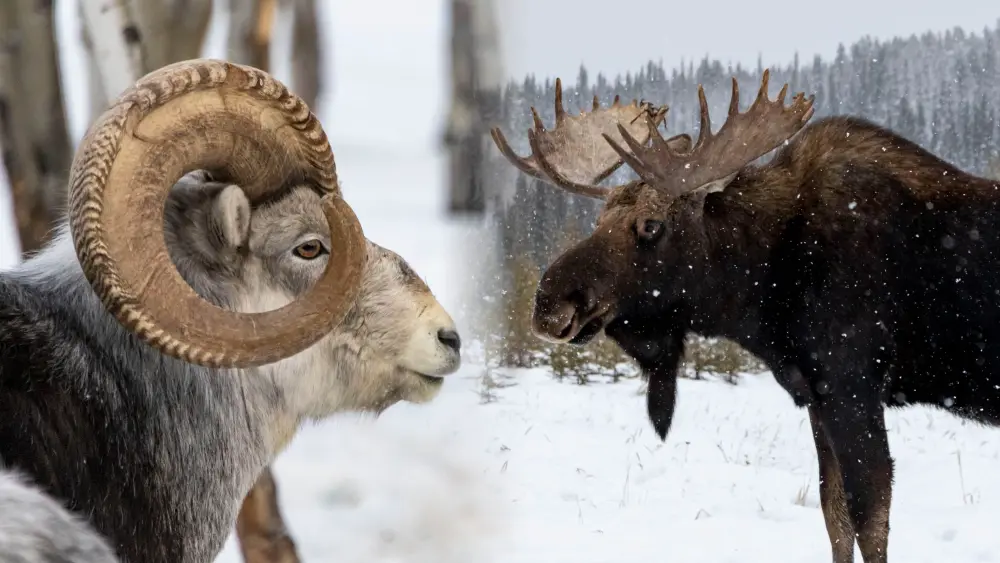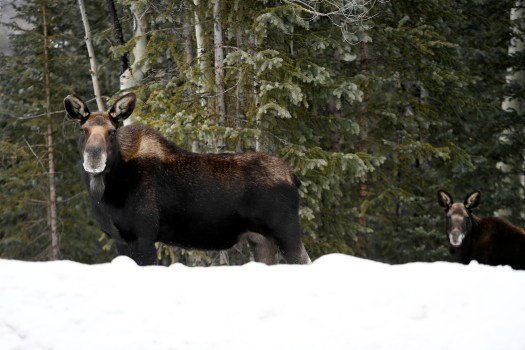Moose mating season typically occurs in the fall, around late September to early October. During this time, moose actively seek out potential mates to reproduce.
As the leaves begin to change and the temperature cools, moose across North America enter their mating season. This period is crucial for the survival of their species, as it is when they engage in courtship behaviors and breeding activities.
Bull moose become more aggressive and vocal as they compete for female attention, often clashing with other males in the process. Cow moose, on the other hand, release pheromones to attract potential suitors. The sight of these majestic animals in their natural habitat during mating season is a remarkable experience for wildlife enthusiasts and photographers alike.
The Timing Of Moose Mating Season
Moose mating season typically occurs in the early autumn, during September and October. This is when male moose become more territorial and aggressive, and females are in estrus. During this season, moose are more active, making it a good time for wildlife enthusiasts to observe their behavior.
Being aware of the timing of moose mating season is essential for understanding their behaviors in the wild. Moose mating season, also known as the rut, typically occurs in the fall. Various factors influence the timing of this critical period in a moose’s life cycle.Moose Mating Season Overview
Moose mating season, or the rut, occurs in the fall when male moose actively seek out female mates for reproduction.Factors Influencing The Timing
1. Environmental Conditions: Moose mating season coincides with the fall when food availability is abundant. 2. Hormonal Changes: Male moose experience a surge in testosterone levels, signaling the onset of the rut. 3. Competition for Mates: Male moose engage in aggressive behaviors to establish dominance and secure mating opportunities. 4. Daylight Hours: The decreasing daylight hours in the fall trigger hormonal changes in moose, signaling the start of the rut. In summary, the timing of moose mating season is influenced by environmental factors, hormonal changes, competition for mates, and daylight hours.
Credit: yukonwildlife.ca
Mating Behavior Of Moose
The Mating Behavior of Moose is characterized by intricate courtship displays and fierce competition among males for breeding rights. Understanding the Mating Behavior of Moose sheds light on their unique rituals and challenges during mating season.
Courtship And Mating Rituals
Moose engage in elaborate courtship rituals to attract mates. This includes vocalizations, such as loud calls and grunts, and physical displays, like antler clashes. Courtship can last for hours before mating occurs.
Challenges And Competition
Moose face intense competition from other males during mating season. They use their size and antlers to intimidate rivals and establish dominance. Only the strongest males earn the right to mate with females.
Impacts Of Mating Season On Moose Population
When is Moose Mating Season?
Moose mating season, also known as the rut, typically occurs in the fall, primarily in late September and early October. During this time, bull moose become more aggressive as they compete for mates, and the forests are filled with the echoing calls of bulls vying for the attention of female moose. The mating season is a crucial period that impacts the overall moose population in various ways.
Reproductive Success
The mating season greatly influences the reproductive success of moose. During this time, female moose, or cows, mate with dominant bulls, leading to successful pregnancies. The timing of mating can influence the number of calves born in a specific year, as well as the overall health and vitality of the moose population.
Survival Rates Of Calves
Following the mating season, the survival rates of moose calves become a critical factor in maintaining the population. Calves born during a successful mating season have better prospects for survival and growth. However, factors such as predation, habitat availability, and food accessibility also play a significant role in determining the survival rates of moose calves.
Moose Mating Season And Human Interaction
The moose mating season is an awe-inspiring yet crucial period in the lives of these majestic animals. During this time, usually occurring in the fall, male moose, known as bulls, engage in competitive and often intense battles for the opportunity to mate with female moose, or cows.
Wildlife Watching Guidelines
Observing moose during their mating season is a thrilling experience. To ensure the safety of both humans and moose, it is essential to adhere to wildlife watching guidelines:
- Keep a safe distance: Moose are large, powerful creatures. Maintain a distance of at least 100 feet when observing them.
- Stay in your vehicle: If you come across moose while driving, remain inside your car. This provides a safe barrier between you and the moose.
- Be aware of your surroundings: Pay attention to your surroundings for signs of moose activity, such as tracks or droppings. This can help you understand their behavior and avoid any potential risks.
Awareness And Conservation Efforts
It is crucial to foster awareness and promote conservation efforts during moose mating season. By respecting their natural habitat and behavior, we can help preserve these magnificent animals for future generations. Here are a few ways individuals can contribute:
- Support local wildlife organizations: Donate to or volunteer with organizations focused on moose conservation, such as wildlife rehabilitation centers or nature reserves.
- Spread awareness: Share educational content on social media or organize community events to raise awareness about moose mating season and the importance of their conservation.
- Practice responsible outdoor activities: When hiking, camping, or engaging in other outdoor activities, follow Leave No Trace principles to minimize impacts on moose and their environment.
By proactively taking these measures, we can ensure a harmonious coexistence between humans and moose, allowing these magnificent creatures to thrive during their mating season and beyond.
Moose Mating Season Across Different Regions
When it comes to the moose mating season, timing and behavior can vary across different regions. These majestic creatures are known for their impressive antlers and distinctive calls during this time.
Variations In Timing And Behavior
Across various parts of the world, moose mating season occurs at different times of the year. While spring is a common period in many regions, the specifics may differ. In North America, for example, moose in the northernmost areas begin their mating rituals as early as September, whereas those in southern regions might not start until November.
During this season, male moose called bulls begin their display of dominance by engaging in fierce battles. These spectacular clashes involve the banging of their antlers as they compete for the attention of female moose, known as cows. To ensure their chances of mating, bulls also emit bellows and grunts that can be heard from kilometers away, signaling their presence and establishing their territory.
Local Wildlife Enthusiast Experiences
Many local wildlife enthusiasts look forward to moose mating season, seizing the opportunity to witness these fascinating events firsthand. From the crisp mountains of Alaska to the dense forests of Scandinavia, people flock to these regions during the appropriate months, armed with cameras and binoculars, eager to capture the magical moments of moose courtship.
Some lucky individuals have had the privilege of observing the rhythmic swaying of antlers as bulls engage in intense duels. Others have marveled at the haunting echoes of bull calls across lakes and valleys. These encounters remind us of the intricate beauty of nature and the vital importance of preserving these remarkable creatures and their habitats.
| Region | Mating Season |
|---|---|
| North America (northern areas) | September |
| North America (southern areas) | November |
| Scandinavia | September – October |
| Alaska | September – October |
To experience moose mating season across different regions is to witness nature’s sublime spectacle. It is a reminder of the diverse rhythms of life within our planet, and a chance to immerse ourselves in the wonders of the natural world.

Credit: www.nytimes.com

Credit: yukonwildlife.ca
Frequently Asked Questions Of When Is Moose Mating Season
When Is Moose Mating Season?
Moose mating season typically occurs in the fall, specifically between late September and early October. During this time, male moose, known as bulls, compete for female moose, or cows, by engaging in displays of dominance and vocalizations. It’s an exciting time to witness these magnificent creatures in their natural habitat.
How Long Does Moose Mating Season Last?
Moose mating season usually lasts for about 4 to 6 weeks. This period allows enough time for bulls to establish territories, attract and mate with cows, and defend their status against other bulls. The intensity of the mating season gradually decreases as more cows are impregnated, eventually leading to the onset of winter and a return to normal behavior for the moose.
What Are The Signs Of Moose Mating Season?
Various signs indicate the arrival of moose mating season. These include increased vocalizations by the bulls, which can be heard from a distance. Additionally, one may observe more aggressive behavior among the male moose as they compete for dominance. Other signs could include visual displays like charging, tree rubbing, and scraping the ground with their antlers.
Where Is Moose Mating Season Most Active?
Moose mating season is most active in areas where moose populations are dense, such as Alaska, parts of Canada, and some areas in the northern United States. These regions provide suitable habitats for moose and offer ample resources for mating and raising offspring.
During the mating season, these areas may witness increased moose activity and encounters.
Conclusion
Understanding moose mating season is essential for wildlife enthusiasts and travelers. By being aware of the timing, behaviors, and habitats during this period, we can minimize disturbances to these majestic creatures and ensure their conservation. Stay informed and respectful of nature’s rhythms to fully appreciate these extraordinary animals.



